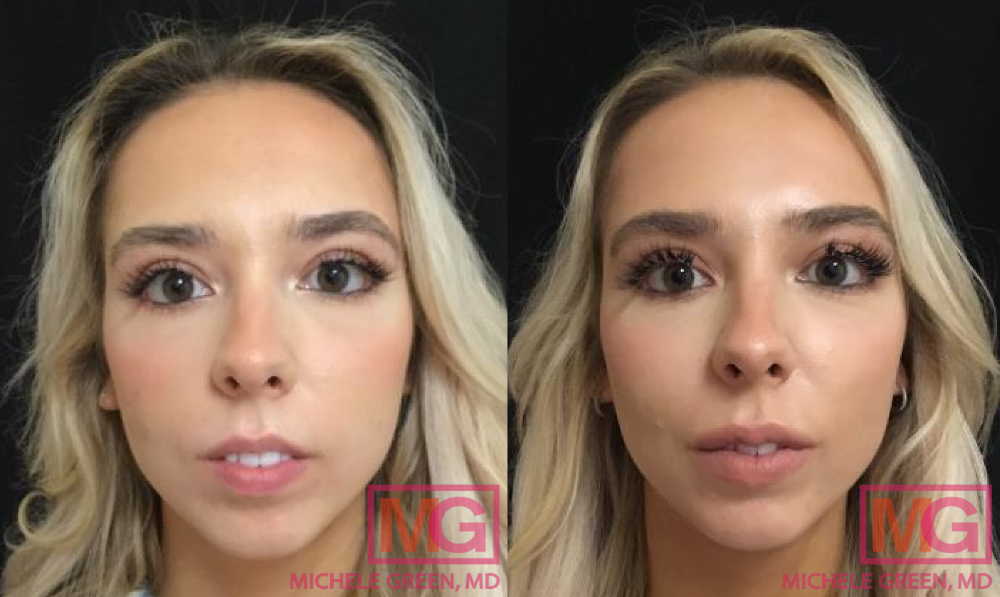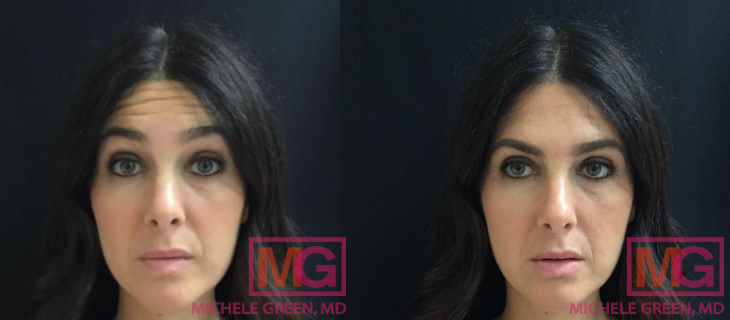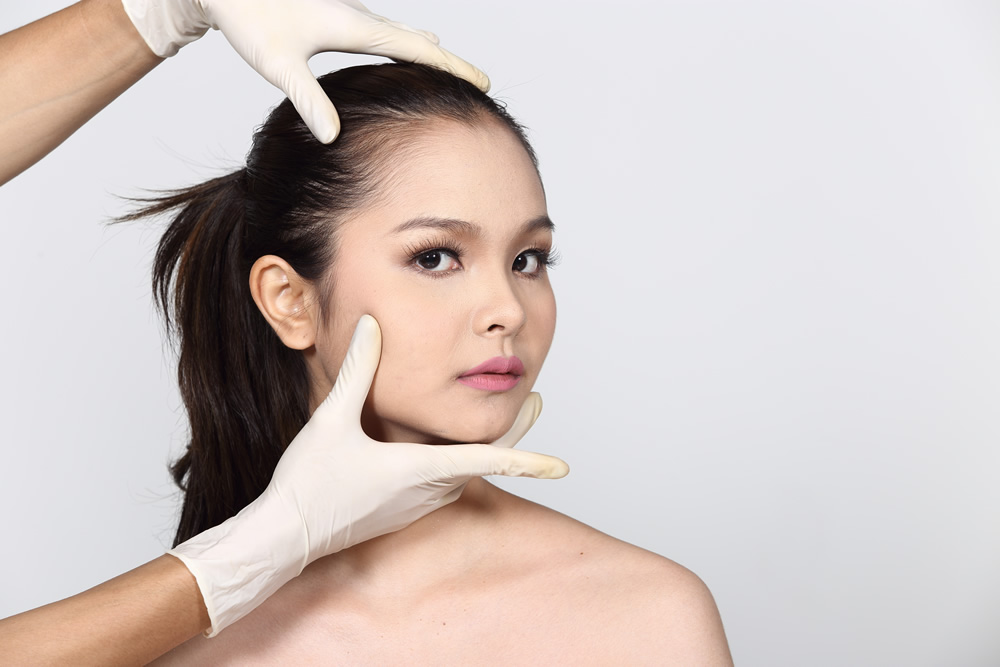What are the Most Common Botox Side Effects?
Over the past two decades, Botox has become one of the biggest names in the world of dermatology, and for good reason. Botox has become an effective tool in cosmetic dermatology, helping to treat dynamic wrinkles and fine lines for optimal facial rejuvenation. Botox is an FDA-approved cosmetic treatment and also has a myriad of medical benefits, including treatment for hyperhidrosis, chronic migraines, TMJ or jaw tension, as well as chronic neck pain and muscle spasms.
However, though Botox can be a positive experience for those who work with a licensed healthcare professional, Botox has developed an unfairly negative reputation due to inexperienced injectors, which can increase risk of serious side effects. When it comes to safe and effective Botox treatment, there is no guide better than board-certified dermatologist Dr. Michele Green. Dr. Green offers vital medical advice to her patients, ensuring a positive and safe experience on a wide variety of treatments.

Botox lip flip – 28 year old
If you’re frustrated with the appearance of fine lines or wrinkles, or are struggling with chronic migraines, hyperhidrosis, or muscle tension, Dr. Green is here to help. Dr. Michele Green was one of the first dermatologists to incorporate Botox in NYC into her private, boutique, dermatology practice. With over 25 years of experience in cosmetic injections, such as Botox, Dysport, Juvederm, Restylane, and Sculptra, Dr. Green is consistently voted as one of New York City’s best dermatologists. By combining skill and artistry, Dr. Green will give you the best Botox injections in New York.
What are Botox Injections?
Botox (onabotulinumtoxinA) is an injection that uses a neurotoxin, called botulinum toxin type A, to “freeze” nerve impulses at or near injection sites. It operates by blocking acetylcholine, a nerve signal that carries pain signals and stimulates activity where nerve endings meet muscle cells. This injectable was approved by the Food and Drug Administration in 2002 for cosmetic use. Botox is most well known for its ability to treat frown lines, crow’s feet, and facial wrinkles, although there are numerous other uses for it. Hyperhidrosis (excessive sweating), chronic migraine, spasticity (muscle stiffness), and strabismus are all conditions that are treatable with botox. When Botox is safely injected by an expert medical professional, it can be a revitalizing and restorative treatment, both for facial rejuvenation and medical care.
Botox is a brand-name for botulinum toxin injectable treatment, created by the pharmaceutical giant Allergan. There are a variety of other FDA-approved treatments that rely on the same bacterium source, Clostridium Botulinum, with varied formulations. These injectable treatments include Xeomin, Dysport, and Myobloc, and are safe and effective alternatives to cosmetic Botox. Though all of these neuromodulators are derived from the same bacteria that causes Botulism, they are formulated in a method that safely targets the injection site and helps to “freeze” the nerve signal of the treatment area, which in turn can help to reduce repeated muscle use and thus relax chronic spasms, pain, or dynamic wrinkles. When prepared and injected by an expert medical professional, these treatments are simple and pain-free, with virtually no downtime.
What are Botox Cosmetic Treatments?
Botox cosmetic treatments use the neurotoxin formulation of Botox to temporarily halt the nerve signal communication to overly-used muscled in the face. As we age, our muscles can often create wrinkles in the skin due to repeated expressions and reactions. Botox is an excellent method to reduce the appearance of crow’s feet, fine lines, frown lines, and other facial wrinkles, and, when applied through methods like micro-Botox, can even be used to prevent dynamic wrinkles from forming in the first place.

Botox for forehead (glabella lines) – 30-39 year old
Does Botox Help 11 Lines?
For patients who experience stress, those sharp vertical lines between the eyebrows tend to deepen over the years. Thankfully, Botox injections are designed to treat dynamic wrinkles just like “11” lines, and can help to not only relax the muscles that cause these facial wrinkles, but also reduce the appearance of these wrinkles for three to six months.
What else can Botox treat?
Botox injections are incredibly effective for facial rejuvenation, and are also commonly used for a myriad of medical conditions. Dr. Green frequently treats patients dealing with hyperhidrosis (excessive sweating) in the underarms or other areas, through the use of Botox injections. Dr. Green is also at the forefront of treatment for TMJ disorder via Botox injections, helping to reduce painful tension in the jaw by slowly relaxing the muscles along the jaw. In turn, this muscle weakness can alleviate tension and pain caused by the master muscle, and reduce the likelihood of TMJ pain returning. Additionally, patients often turn to Botox injections to treat chronic migraines in order to reduce headache frequency.
Botox is an excellent treatment for a variety of other muscle-based medical conditions, including lazy eye, eye twitching (blepharospasm), muscle spasms, cervical dystonia, and bladder dysfunction. Botox injections have been proven to help with urinary incontinence (leakage) due to an overactive bladder, which can be vital in improving quality of life for patients with bladder dysfunction.
What are the long-term effects of Botox injections?
For many patients, long-term use of Botox can have wonderful effects. Particularly when it comes to cosmetic treatment, continued use of Botox can help to relax the facial muscles and, in turn, reduce the severity of dynamic wrinkles. For many who continually use Botox in the form of micro-botox or touch-up injections, Botox actually can manage to “turn back the clock” on aging, creating natural-looking rejuvenation thanks to Dr. Green’s less-is-more philosophy and artful hand.
For patients who suffer from issues such as TMJ disorder, chronic migraines, or hyperhidrosis, a series of Botox treatments can help to permanently improve quality of life. Botox’s ability to disrupt nerve signals to targeted muscles can in turn reduce symptoms of pain caused by overactive muscle groups, and its non-invasive nature can allow patients to heal with no downtime needed.

Does Botox have Side Effects?
In general, Botox is considered a non-invasive treatment, meaning that it can be completed in a short in-office session with no downtime required and incredibly minimal risk. However, Botox injections can have side effects. Typically, side effects of Botox are very mild, and are common amongst injectable treatments. These symptoms include pain, bruising or swelling near the injection site.
What are the side effects of Botox injections?
For most patients, Botox has few or no side effects. However, in rare cases, patients may experience more uncomfortable side effects. Possible side effects include drooping eyelids, dry eyes or excessive tearing, or some temporary asymmetry. However, the majority of patients experience very few side effects, particularly when working with a licensed and trained medical expert.
When you work with Dr. Green, she will carefully examine your medical history, as well as talk about your individual needs and goals, in order to determine which treatment plan is best for you. In this way, Dr. Green can be sure to avoid treatments that may cause an allergic reaction, as well as determine if you are an appropriate candidate for Botox injectable treatment.
Who is a good Candidate for Botox?
A good candidate for Botox injections is any adult who is interested in facial rejuvenation or medical treatment via Botox. However, Botox is contraindicated for patients who are pregnant or breast-feeding, patients who have a known allergy to neurotoxins, or patients who have a history of neurological or nervous system diseases, such as Lou Gehrig’s disease (amyotrophic lateral sclerosis), myasthenia gravis, or lambert-eaton syndrome.
How long do the side effects of Botox last?
So, when do Botox side effects go away? For most patients, any mild swelling or bruising at the injection site will dissipate over the course of 2-3 days following treatment. For those who experience more moderate side effects, it’s important to talk to your healthcare provider to ensure that side effects can be quickly alleviated.
Can Botox cause Nausea?
Some patients wonder, can Botox make you nauseous? Though it is extremely uncommon, Botox can occasionally cause flu-like symptoms, which can include nausea. However, this side effect is rather uncommon, and typically patients will feel back to normal shortly after their treatment session.
What are the bad side effects of Botox?
Through her expansive knowledge and expertise in regards to cosmetic injectable treatments, Dr. Green is able to offer a safe and successful treatment experience with Botox. However, many medical spas and “Botox parties” offer Botox treatments with inexperienced injectors, and this can lead to serious side effects. In these environments, health and safety are at greater risk, and the toxin could spread into the body. If you have recently received Botox injections from an inexperienced injector and are experiencing muscle weakness, blurred vision or double vision, difficulty breathing, difficulty speaking, painful urination, or urinary incontinence, contact a healthcare professional immediately.

Are Botox side effects permanent?
Side effects caused by Botox injections typically resolve a few days after treatment. In rare cases, side effects such as droopy eyelids can last several weeks after treatment. Nevertheless, most side effects from Botox resolve on their own, within a few months, and are not permanent.
Does Botox have long-term side effects?
In rare events, patients can be exposed to toxin spread, and Botox can lead to an infection akin to botulism, can have severe side effects and must be treated immediately. Inexperienced injectors are in large part the cause of severe risk or long-term side effects during Botox injections, which is why it is essential you work with an experienced medical professional for any Botox injections or treatment. When you work with Dr. Green, you can be comforted by her incredible expertise. The safety and satisfaction of her patients is Dr. Green’s top priority.
If you are seeking treatment for facial rejuvenation, Baby Botox, facial slimming, hyperhidrosis, chronic migraines, or TMJ disorder, Botox injections may be the solution you’ve been waiting for. Dr. Michele Green is an internationally renown dermatologist and a platinum Botox user in NYC. With over two decades of experience in cosmetic injections and accolades from New York Magazine, Best Doctors, Castle Connolly, and the New York Times, Dr. Green will tailor-make the best Botox treatment for you. Please contact our NYC based office today or call 212-535-3088 to develop your custom treatment plan with Dr. Green.
 212-535-3088
212-535-3088